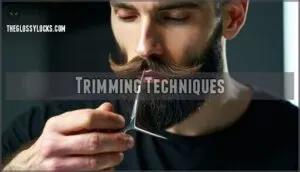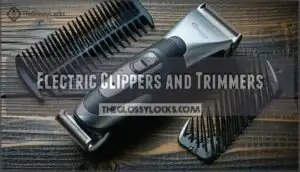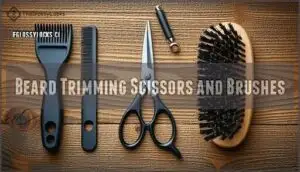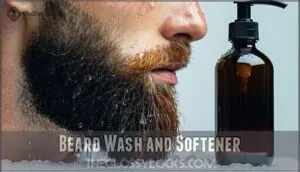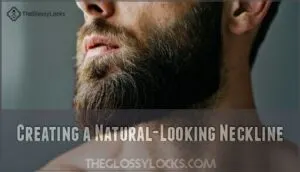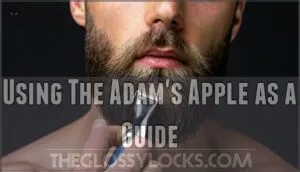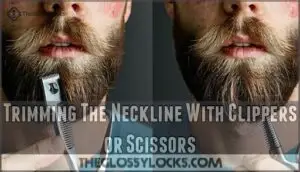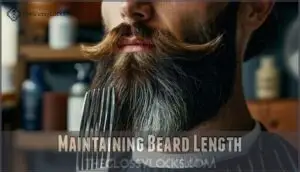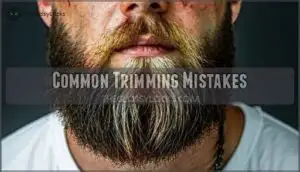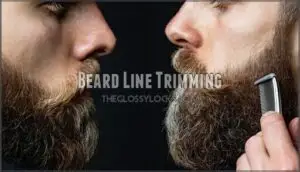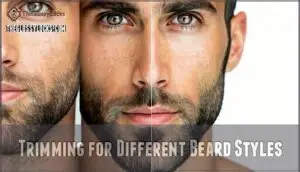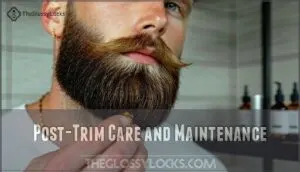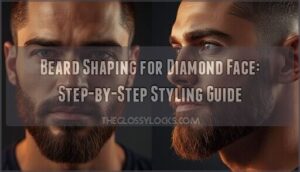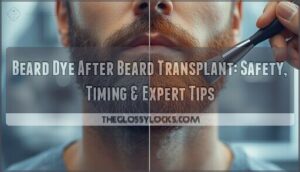This site is supported by our readers. We may earn a commission, at no cost to you, if you purchase through links.
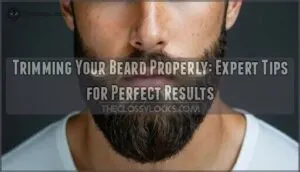
You’ll want to trim with the grain, not against it, to avoid irritation and maintain natural growth patterns. Start longer than your target length since you can always cut more, but you can’t add hair back once it’s gone.
Focus on creating clean lines at your neckline (about two fingers above your Adam’s apple) and cheekline while keeping your mustache trimmed above your lip line.
The secret isn’t just knowing where to cut, but understanding the subtle techniques that separate amateur attempts from professional-looking results.
Table Of Contents
- Key Takeaways
- Preparing Your Beard
- Trimming Techniques
- Beard Trimming Tools
- Top 8 Beard Trimming Essentials
- Trimming Your Neckline
- Maintaining Beard Length
- Common Trimming Mistakes
- Beard Line Trimming
- Trimming for Different Beard Styles
- Post-Trim Care and Maintenance
- Frequently Asked Questions (FAQs)
- Conclusion
Key Takeaways
- You’ll want to wash and dry your beard completely before trimming – wet hair cuts unevenly and appears longer than it actually is, leading to over-trimming mistakes once it dries
- Start with longer guard settings and work your way down gradually – you can always trim more hair off, but you can’t magically grow back what you’ve cut too short
- Define clean lines at your neckline (two fingers above your Adam’s apple) and cheekline – these boundaries separate a polished beard from an unkempt mess and frame your face properly
- Trim with the grain, not against it, using quality tools – following your hair’s natural growth pattern prevents irritation while sharp clippers and scissors ensure clean, even cuts
Preparing Your Beard
Before you start trimming, you’ll need to properly prepare your beard to guarantee an even, professional-looking result.
Think of it like prepping a canvas before painting – without this vital step, even the best trimming technique won’t save you from an uneven mess, which is why complete concepts like preparation are crucial for a good outcome, and considering it as prepping is essential.
Washing and Drying The Beard
Before diving into trimming, proper preparation sets the foundation for professional-looking results. Start by washing your beard with a dedicated beard wash rather than regular shampoo, which strips natural oils. Use lukewarm water temperature to avoid irritation while guaranteeing effective cleansing.
Here’s your essential wash and dry routine:
- Choose sulfate-free beard wash to prevent product buildup
- Rinse thoroughly to remove all residue from your beard care routine
- Pat dry with a clean towel—never rub vigorously
- Allow air drying for 5-10 minutes before trimming
- Check for complete dryness to guarantee accurate cutting
Proper drying methods substantially impact softness and manageability. Wet hair cuts unevenly, leading to surprises once it dries. This simple beard maintenance step prevents those "oops" moments that require damage control, ensuring a professional-looking result with effective cleansing and manageability.
Combining and Brushing The Beard
Detangling is your first move after washing—work through knots gently to avoid breakage.
Use a quality comb with smooth teeth to guide hairs in their natural growth direction, creating the perfect canvas for trimming.
Different brush types serve specific purposes: boar bristle brushes distribute natural oils while synthetic options handle thicker beards.
This beard grooming step guarantees even product distribution and reveals your beard’s true shape before you start cutting, ensuring a perfect canvas for further styling.
Using Boar Bristle Brushes and Dual-Sided Combs
Once you’ve combed through tangles, choosing the right tools makes all the difference in your beard grooming routine.
Bristle Brush Benefits shine when you need to distribute natural oils evenly—boar bristles work like tiny oil distributors, reducing itch and adding shine.
Comb Material Matters too; sandalwood combs prevent static while wooden options last longer than plastic alternatives.
Detangling Techniques work best with dual-sided combs—use wide teeth for thick hair, fine teeth for precision Styling Applications and Maintenance Practices during beard care.
Many users find a quality boar bristle brush essential.
Trimming Techniques
Now you’ll master the actual techniques that turn an overgrown beard into a polished masterpiece.
The key lies in working with your hair’s natural growth pattern and taking your time to create clean, defined lines that frame your face perfectly.
Trimming in The Direction of Hair Growth
Now that your beard’s clean and properly prepared, trimming with the grain becomes your best friend for irritation prevention and achieving a natural look.
Following your hair’s growth patterns prevents painful hair tugging while delivering even cuts that look professionally done.
Most beards grow downward and outward, but check your unique patterns first.
This fundamental beard trimming technique separates amateur attempts from expert-level beard trimming results, making it a cornerstone of any solid beard trimming guide that ensures expert-level results.
Maintaining The Mustache and Cheeklines
Proper mustache maintenance and cheekline definition create the foundation for professional beard trimming results.
These facial features frame your beard and require precise shaping techniques to achieve symmetry balance.
Focus on these key areas for ideal mustache styles and cheekline shapes:
- Mustache trimming: Keep hair above your upper lip neat, preventing overgrowth that covers your mouth
- Cheek line definition: Trim stray hairs above your main beard line for clean borders
- Defining borders: Use straight or curved cheekline shapes based on your facial structure
- Beard trimming consistency: Maintain regular mustache maintenance to complement your overall look
Defining The Neckline and Jawline
Carving out that perfect jawline definition starts with locating your Adams Apple as your anchor point.
Your neckline shape should follow an imaginary curved line connecting ear to ear, sitting about one finger’s width above this landmark. This creates a natural fade that enhances your facial structure without looking artificial.
| Neckline Element | Technique | Common Mistake |
|---|---|---|
| Upper Boundary | Use Adams Apple as guide, trim one finger above | Setting line too high, creating "floating" beard |
| Side Angles | Follow natural jaw curve toward ears | Creating harsh straight lines instead of curves |
| Stray Hairs | Remove with razor or shortest clipper setting | Leaving uneven patches below defined line |
| Cheek Line | Trim connecting sideburn to mustache naturally | Over-defining or creating unnatural sharp angles |
| Neckline Trimming | Start longer, gradually shorten for precision | Cutting too short initially, removing too much hair |
Focus on neckline shaping that complements your bone structure. Cheekline definition should feel natural—think gentle cleanup rather than architectural precision.
Beard Trimming Tools
You’ll need the right tools to achieve a professional-looking trim that enhances your facial features and maintains your beard’s health.
Having quality clippers, sharp scissors, and proper cleansing products makes the difference between a salon-worthy result and an uneven mess that’ll have you reaching for a hat.
Electric Clippers and Trimmers
Modern electric trimmers pack serious power into compact designs, offering up to 120 minutes of cordless operation.
You’ll find high-carbon steel blades outperform standard options, while adjustable guard lengths from 0.2mm to longer styles give you complete control.
Waterproof designs make clipper maintenance a breeze, and ergonomic grips prevent those "oops" moments.
Choose corded vs. cordless based on your routine—cordless wins for convenience, corded for consistent motor types performance.
Electric trimmers also offer enhanced grooming routines by saving time.
Beard Trimming Scissors and Brushes
While electric clippers handle bulk trimming, you’ll need finer tools for detailed work.
Professional-grade beard trimming scissors let you target individual hairs with precision, while quality grooming tools make all the difference in your routine.
Here’s what to look for in scissors and brushes:
- Scissors Material – Choose stainless steel blades that stay sharp longer and resist rust
- Ergonomic Handles – Look for comfortable grips that prevent hand fatigue during detailed beard trimming
- Brush Bristles – Boar bristle brushes distribute natural oils best, while synthetic options suit sensitive skin
- Scissor Maintenance – Keep blades sharp through regular cleaning and professional sharpening when needed
- Brush Cleaning – Wash brushes weekly with gentle soap to remove product buildup and maintain hygiene
Scissors excel where clippers can’t reach, giving you surgical control over stray hairs.
Consider browsing a site for specialized beard products to find the right tools.
Meanwhile, proper beard brushing before trimming aligns hairs for even cuts.
Beard Wash and Softener
Beard wash ingredients matter more than you’d think—sulfates strip natural oils while gentle cleansers preserve them.
Quality beard softening products contain nourishing oils that penetrate hair shafts, reducing brittleness.
| Product Type | Key Benefits | Application Tips |
|---|---|---|
| Beard Wash | Removes dirt without over-drying | Use 2-3 times weekly |
| Beard Softener | Reduces coarseness, prevents tangles | Apply to damp beard daily |
| Conditioning Products | Prevents residue buildup, adds moisture | Rinse thoroughly after use |
Choose beard care products based on scent preferences and skin sensitivity.
Beard conditioning prevents split ends while proper product application guarantees maximum softener benefits without residue buildup.
Top 8 Beard Trimming Essentials
Having the right tools makes all the difference between a professional-looking trim and a patchy disaster.
You’ll need these eight essentials to achieve salon-quality results at home, from proper cleansing products to precision cutting instruments.
1. Every Man Jack Sandalwood Wash
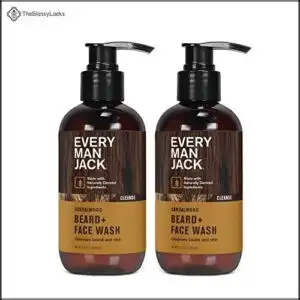
Most professional barbers swear by one golden rule: start with a clean canvas. Every Man Jack Sandalwood Wash delivers exactly that, cleansing your beard without stripping natural oils that keep hair healthy.
This dual-purpose formula works on both beard and face, saving you precious grooming time. The coconut-derived surfactants lift away dirt while glycerin locks in moisture.
You’ll appreciate the warm sandalwood scent—woody and spicy without overwhelming your other products. At under fifteen dollars, it’s trusted by over five million men worldwide for good reason, making it a highly trusted and affordable option.
Best For: Men looking for a gentle, natural beard and face wash that saves time and keeps hair and skin healthy.
- Cleanses beard and face without stripping natural oils.
- Pleasant sandalwood scent that’s not overpowering.
- Suitable for sensitive or dry skin and daily use.
- Some users report slight dryness after use.
- Occasional issues with pump dispenser or shipping leaks.
- Scent fades quickly after application.
2. Every Man Jack Unscented Wash
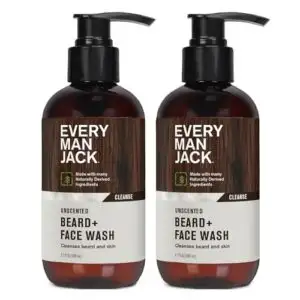
If you’re sensitive to strong scents, you’ll appreciate this unscented option.
Every Man Jack’s fragrance-free wash combines coconut-derived cleansers with aloe vera to gently clean both your beard and face without harsh chemicals.
The dermatologist-tested formula won’t compete with your cologne or trigger skin reactions.
It’s particularly effective for daily use, creating a light lather that rinses clean while keeping your beard soft and manageable.
Best For: Men with sensitive skin who want a gentle, fragrance-free beard and face wash that won’t cause irritation or clash with cologne.
- Cleanses beard and face without harsh chemicals or added fragrances.
- Dermatologist-tested formula with soothing aloe vera for daily use.
- Leaves beard soft, manageable, and less prone to itch or dryness.
- Minimal lather may not suit those who prefer a foamier wash.
- Occasional reports of dryness if used too frequently.
- Packaging can be prone to shipping damage or pump issues.
3. Cremo Boar Bristle Beard Brush

The Cremo Boar Bristle Beard Brush delivers professional-grade grooming with 100% natural boar bristles that distribute oils evenly while massaging your skin.
This ergonomic wooden-handled brush reduces beardruff by exfoliating dead skin cells and stimulates blood flow for thicker growth.
Unlike synthetic alternatives, these dense bristles absorb and distribute beard products effectively, taming even the most stubborn whiskers, making it perfect for daily training sessions to keep your mane looking sharp.
Best For: Anyone looking for a reliable, professional-grade brush to tame, style, and maintain thicker or unruly beards, especially those using beard oils or balms.
- 100% natural boar bristles provide effective styling, shaping, and even product distribution.
- Ergonomic wood handle offers comfortable grip for daily grooming at home or on the go.
- Massages and exfoliates skin to reduce beardruff and promote healthier beard growth.
- Some users find the bristles initially rough or too stiff for sensitive skin.
- Occasional reports of bristle shedding, especially with frequent or vigorous use.
- Requires regular cleaning and careful drying to prevent odor and prolong lifespan.
4. Cremo Premium Natural Wood Beard Comb
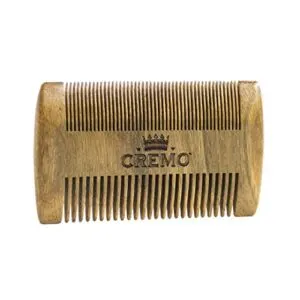
Natural wood brings old-school craftsmanship to modern grooming.
You’ll appreciate this dual-tooth design that tackles both coarse, curly hair and fine, straight strands with ease.
The 100% Verawood construction delivers that subtle woodsy fragrance while distributing oils evenly through your beard.
At 4.5×2.9 inches, it’s perfectly portable for travel touch-ups.
Sure, some users mention static electricity issues, but the anti-static properties and smooth combing experience make it worth keeping in your grooming arsenal.
Best For: Gentlemen who want a durable, natural wood comb for all beard types and gifting occasions.
- Can create static electricity for some users.
- Wooden material may crack if dropped or handled roughly.
- Woodsy scent fades after a week of regular use.
- Dual-tooth design works for both coarse/curly and fine/straight beards.
- Made from 100% Verawood with a subtle, natural woodsy fragrance.
- Compact and sturdy, great for daily use or travel.
5. Braun Series 7 All-in-One Trimmer
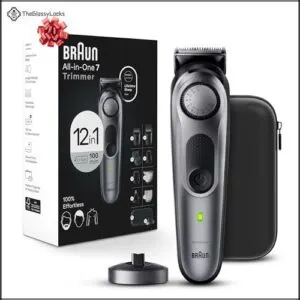
Setting up your trimmer correctly can make or break your grooming game.
The Braun Series 7 All-in-One delivers with its precision wheel featuring 40 length settings in 0.5mm increments, giving you complete control over your beard’s destiny.
Its AutoSense technology adapts to hair thickness, while the 100-minute battery life means you won’t get caught mid-trim.
With ProBlade technology and lifetime sharp blades, this versatile kit handles everything from detailed edging to full beard maintenance with professional results.
Best For: Those seeking a versatile, all-in-one grooming tool with customizable settings for beard, body, and detail work.
- Wide range of attachments and adjustable lengths for personalized grooming.
- Long-lasting battery with 100 minutes of cordless runtime.
- ProBlade and AutoSense technology deliver smooth, efficient cuts for all hair types.
- Some users report durability concerns with plastic parts.
- Travel case may be too small for all accessories.
- Premium price compared to basic trimmers.
6. King C. Gillette Beard Trimmer Kit
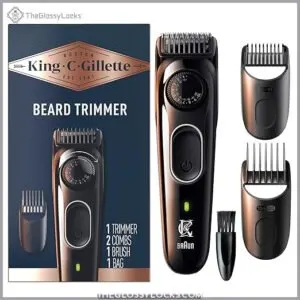
When you’re ready to step up your beard trimming game, the King C. Gillette Beard Trimmer Kit delivers solid performance without breaking the bank.
You’ll get 40 precise length settings from 1mm to 21mm, plus three interchangeable combs that handle everything from stubble to full beards.
The 50-minute battery life covers about a month’s worth of quick touch-ups, though some users report shorter runtime than advertised.
Sharp blades stay effective for months, and the washable head makes cleanup a breeze.
Best For: Guys who want an affordable, easy-to-use trimmer for maintaining stubble, short, or mid-length beards.
- Wide range of lengths and precise adjustment with 40 settings
- Sharp blades and washable head make grooming and cleanup simple
- Good kit value with multiple combs, charger, brush, and pouch included
- Battery performance is inconsistent and can’t be used while charging
- Mild cutting power may require extra passes on coarse or thick beards
- No nose trimmer attachment; some users report short charging cable
7. Refine 5 inch Hair Shears
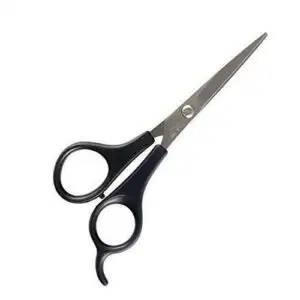
Precision becomes your greatest ally when shaping facial hair.
These 5-inch stainless steel shears deliver surgical-like accuracy for trimming stray hairs and defining beard edges.
You’ll find their compact size perfect for detailed work around your jawline and mustache—areas where clippers often miss the mark.
The ergonomic handle reduces hand fatigue during longer grooming sessions.
Unlike bulky scissors, these shears give you complete control for gradual shaping and fine-tuning, making over-trimming practically impossible.
They provide complete control and are ideal for detailed work, ensuring a precise finish.
Best For: Precision-focused individuals seeking complete control over beard, mustache, or detailed facial hair grooming.
- Compact 5-inch blades allow precise trimming and shaping in hard-to-reach areas.
- Ergonomic and lightweight design reduces hand fatigue and supports extended use.
- Delivers gradual, controlled cuts with minimal risk of over-trimming or mistakes.
- Not as sharp as some high-end brands, requiring more careful technique.
- Less effective for rapid bulk removal compared to clippers or larger shears.
- Regular maintenance needed to prevent rust and maintain long-term performance.
8. Oars Alps Hydrating Beard Oil
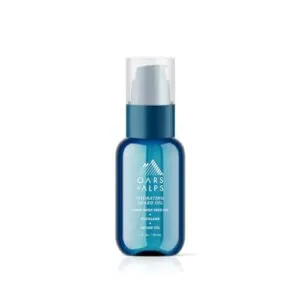
After thorough trimming, you’ll want proper aftercare to keep your beard looking sharp.
Oars Alps Hydrating Beard Oil delivers exceptional moisture with sunflower seed oil, plant-derived squalane, and argan oil.
Just 2-3 drops massaged into your freshly trimmed beard will soften whiskers, nourish underlying skin, and prevent flakiness.
The lightweight formula won’t leave you looking greasy, while its cardamom and evergreen scent adds a refined finishing touch to your grooming routine.
Best For: Anyone seeking a lightweight, hydrating beard oil with clean ingredients and a subtle, sophisticated scent, suitable for all skin types including sensitive skin.
- Deeply hydrates both beard and skin, helping prevent dryness and flakiness
- Lightweight, non-greasy formula with a premium scent and packaging
- Clean, vegan, and phthalate-free ingredients for sensitive or allergy-prone users
- Some users report skin irritation or burning sensations
- Scent may be too strong for those preferring unscented products
- Mid-range price may be higher than basic beard oils
Trimming Your Neckline
Trimming your neckline can make the difference between a sharp, intentional beard and one that looks like it’s slowly taking over your shirt collar.
You’ll want to use the Adam’s apple as your guide and choose your tools carefully—no one wants to explain a patchy neck at work on Monday.
Creating a Natural-Looking Neckline
A well-defined neckline separates a sharp beard from an unkempt mess. Your goal isn’t perfection but creating an arched line that follows your natural jaw structure.
This neckline fade should enhance your jawline definition while maintaining the beard’s overall balance.
- Find your natural boundary: Place two fingers above your Adam’s apple – this creates the perfect starting point for most beard styles
- Follow the curve: Trim along an imaginary arched line connecting ear to ear, staying consistent with your jaw’s natural shape
- Clean up stray hairs: Remove any neck hair below your defined line using clippers or a razor for crisp beard shaping
Using The Adam’s Apple as a Guide
Your Adam’s apple serves as the perfect landmark for neckline placement.
Position your trimming line about one finger-width above this natural marker to create proportional beard shaping.
This technique prevents the common mistake of trimming too high, which shrinks your beard’s appearance.
A clean neckline requires regular trimming schedule to avoid overgrowth.
Different Adams Apple variations require slight adjustments, but this universal rule works for most beard styles and trimming techniques, ensuring your natural neckline complements your cheek line perfectly, and helps to avoid overgrowth, while maintaining a clean neckline and achieving proportional beard shaping.
Trimming The Neckline With Clippers or Scissors
Once you’ve defined your neckline shape, choosing between clippers or scissors depends on your beard’s length and desired precision.
Both beard trimming techniques offer distinct advantages for achieving clean beard styles.
- Use clipper guards for consistent length and easy blending fade
- Choose scissors technique for detailed work on longer beards
- Start conservatively – avoiding mistakes means trimming less initially
- Work gradually with beard trimmers to refine the neck line
Short beards respond well to clippers, while longer styles often need scissors for natural tapering.
Maintaining Beard Length
Keeping your beard at the right length isn’t just about looking good—it’s about maintaining healthy hair that grows evenly and stays strong.
Regular trimming every 7-10 days prevents split ends while strategic combing helps you control length and catch problem areas before they become obvious.
Trimming Every 7-10 Days
Why wait longer than necessary when your beard’s already telling you it needs attention?
Consistent beard trimming every 7-10 days maintains the best frequency for style maintenance and split end prevention.
This regular beard maintenance routine keeps your growth habit impact positive, preventing unruly hairs from sabotaging your look.
Following proper beard trimming frequency guarantees consistent shaping while using effective beard trimming techniques.
Think of it as preventive maintenance—your beard trimming tips arsenal working overtime to keep you looking sharp.
Using a Comb or Brush to Maintain Length
Two key comb types excel at maintaining beard length: wide-tooth combs for detangling and fine-tooth combs for precision styling.
Daily brushing frequency using a quality beard comb helps assess current length and identifies areas needing attention.
Start detangling from the bottom up—this prevents breakage while giving you a clear picture of your beard’s true dimensions.
Regular use can also help with even oil distribution for a healthier beard.
Remember, your comb’s styling influence shapes how your beard appears, making regular combing essential for any beard trimming tutorial or achieving consistent beard styles.
Preventing Split Ends and Breakage
Beyond regular brushing, you’ll want to protect your beard from damage that leads to unsightly split ends.
Poor beard care habits can turn your well-trimmed masterpiece into a frizzy mess faster than you’d think.
Here’s your split-end prevention playbook:
- Hydration Importance – Apply beard oil twice weekly to nourish hair shafts
- Conditioning Frequency – Use beard balm after every wash for moisture retention
- Trimming Schedule – Stick to 7-10 day intervals to catch damage early
- Product Selection – Choose quality beard care products over generic alternatives
- Gentle Handling – Pat dry instead of aggressive towel rubbing
Common Trimming Mistakes
Even experienced beard groomers make mistakes that can turn months of growth into a patchy disaster.
You’ll learn to spot these common pitfalls before they happen and discover simple techniques to fix errors when they do occur, helping to prevent a disaster and promote healthy beard growth.
Over-Trimming and Patchiness
Over-trimming creates beard disasters that’ll haunt your mirror for weeks. Start conservatively with longer guard settings, then work down gradually. Remember: you can always trim more, but regrowing takes patience and time.
A vital first step involves applying beard oil and butter before you even begin.
| Problem | Solution |
|---|---|
| Uneven patches | Use longer guards, trim incrementally |
| Asymmetrical sides | Mark desired length before cutting |
| Too-short sections | Let regrow 2-3 weeks before reshaping |
| Choppy appearance | Blend with scissors, avoid harsh lines |
| Length miscalculation | Always start one setting longer than intended |
Corrective Techniques require strategic patience. Prevention Strategies beat damage control every time. Focus on Symmetry Focus and gradual Length Regrowth when beard trimming mistakes occur.
These Patchiness Solutions address common beard trimming challenges while maintaining your desired style.
Uneven Growth and Skin Irritation
Using dull tools and rushing can trigger skin irritation beyond just uneven beard growth.
Dull clippers tug at facial hair, creating inflammation and redness that sensitive skin can’t handle.
Poor trimming techniques cause ingrown hairs, especially around your neckline where hair direction changes.
For irritation prevention, maintain sharp tools, trim slowly, and moisturize beforehand.
Quality grooming products help stimulate healthy beard growth while protecting against patchy beard fixes that damage follicles permanently.
Correcting Mistakes and Preventing Future Errors
When beard trimming goes wrong, don’t panic—most mistakes can be fixed with patience. For patchiness solutions, use longer guard settings to even things out gradually.
Over-trimming avoidance starts with taking less off initially; you can always trim more later. If you’ve created razor bumps or skin irritation, give your face a few days to heal before attempting corrections.
The key to avoiding future beard mistakes lies in proper preparation, using sharp tools, and maintaining symmetry balance throughout your trimming session.
Beard Line Trimming
In defining your beard’s boundaries, proper line trimming makes the difference between looking sharp and looking scruffy.
You’ll focus on three critical areas—the cheek line, back line, and neckline—each requiring specific techniques to create clean, natural-looking edges that complement your facial structure.
The techniques for these areas are crucial as they help in creating clean edges that make your beard look well-groomed.
Cheek Line Trimming and Shaping
After avoiding common mistakes, proper cheek line trimming becomes your ticket to a polished look.
The ideal cheek line follows your natural growth pattern, connecting sideburn to mustache.
Keep it high as naturally possible—going too low creates a pinched appearance that kills your beard density.
Trim stray hairs above this line with clippers on low settings, then finish with a razor for sharp definition.
Remember, symmetry concerns are real, so match both sides visually before calling it complete.
Back Line Trimming and Shaping
Creating clean back lines requires precision and patience. Your back line runs from your sideburn straight down to your jawline’s rear corner, removing any stray hairs that grow behind this invisible boundary.
- Start at the sideburn and imagine a straight vertical line down to your jaw
- Use a handheld mirror to check both sides for perfect symmetry assessment
- Trim with clippers first, then finish with a razor for sharp definition
- Work slowly outward from the center to maintain consistent hair density
- Avoid cutting into beard sides – this ruins your overall beard shape
Back line definition separates a polished beard from an unkempt one. These beard shaping techniques create that coveted side profile that’ll have people doing double-takes. Remember, you can always trim more, but growing it back takes weeks.
Neck Line Trimming and Shaping
The neckline represents your beard’s foundation—get it wrong, and you’ll look like you’re wearing a chin strap.
Position it two fingers above your Adams Apple, creating a U-shaped curve from ear to ear.
Start at the center and work outward, following natural contours.
This beard trimming technique enhances jawline definition while maintaining proper beard shape.
Remove stray hairs below this line with clippers for clean goatee edges and neckline fade effects.
Trimming for Different Beard Styles
Different beard styles require specific trimming approaches to achieve their signature look.
Whether you’re maintaining a neat stubble or sculpting a full goatee, adjusting your technique makes all the difference in creating a polished result.
Trimming a Short Beard
Short beard trimming requires precision and patience to achieve that perfectly groomed look.
Keep your lines sharp and your technique consistent for superior results.
Here’s your short beard game plan:
- Use shorter clipper guards (1-3mm) for even length throughout
- Trim every 2-3 days to maintain that crisp stubble maintenance routine
- Define edges carefully around cheeklines and neckline for clean short beard styles
- Practice tapering techniques by gradually reducing guard length near edges
Daily grooming becomes effortless once you nail these beard trimming steps for a short beard.
Trimming a Long Beard
Long beards require strategic trimming to maintain their majestic appearance.
Focus on weight distribution by using tapering techniques—trim sides shorter than the center for balanced proportions. Start with beard trimming scissors for precision work, snipping stray hairs that disrupt your beard shape.
Regular detangling methods prevent knots that make trimming harder. Use quality beard trimming tools and follow proper beard trimming steps: wash, detangle, then trim systematically.
For ideal results, consider washing and towel drying before trimming. Long beard styles demand patience—less frequent cuts preserve length while maintaining health through careful length maintenance.
Trimming a Goatee or Stubble Beard
Goatee shaping requires precision and patience to achieve clean lines.
Use your trimmer’s shortest setting to define edges around the mouth and chin area.
For stubble maintenance, keep settings between 1-3mm for even coverage.
Start with longer trimmer settings and gradually reduce length for better control.
Shape your goatee by outlining the desired perimeter first, then fill in.
Remember, beard trimming tools make all the difference – sharp scissors handle detail work while quality clippers manage bulk removal efficiently.
Post-Trim Care and Maintenance
After trimming your beard, you’ll want to lock in that fresh look with proper aftercare. The right post-trim routine keeps your beard healthy, soft, and looking sharp between trimming sessions.
Applying Beard Oil or Balm
After trimming, your beard needs proper hydration to stay healthy and manageable.
Beard oil delivers moisture to both hair and skin, reducing itchiness and preventing flakiness.
Here’s your post-trim routine:
- Apply beard oil – 3-5 drops distributed evenly through damp beard
- Follow with beard balm – provides extra nourishment and light hold
- Use twice weekly – maintains ideal skin health and beard softening
This conditioning approach prevents dryness while keeping your freshly trimmed beard looking polished.
Using a Conditioner to Prevent Dryness
Several beneficial conditioning ingredients work wonders on your freshly trimmed beard.
Apply conditioner after each wash, leaving it for 3-5 minutes to penetrate hair follicles effectively. This practice prevents dryness and breakage while improving manageability between trims.
| Conditioner Type | Application Method |
|---|---|
| Regular Conditioner | Apply after washing, rinse after 3-5 minutes |
| Deep Conditioning | Leave for 10-15 minutes weekly for coarse beards |
| Leave-in Benefits | Apply small amount to damp beard, don’t rinse |
| DIY Conditioners | Natural oils mixed with carrier ingredients |
Brushing or Combing The Beard for a Polished Look
After your trim wraps up, grab your trusty beard comb and brush to seal the deal on a polished look.
Daily brushing distributes natural oils throughout your beard, boosting shine while stimulating blood flow for healthier growth.
The right brush technique with quality comb material prevents tangles and trains hair direction.
Detangling methods vary by beard texture, but consistent grooming routine delivers styling benefits that transform your beard appearance from scraggly to sophisticated.
Combining both tools can provide optimal beard care for complete concepts of beard maintenance.
Frequently Asked Questions (FAQs)
What is the correct way to trim a beard?
Start by washing your beard thoroughly, then comb it to detangle and assess growth patterns.
Use longer clipper settings first, gradually shortening while defining your cheekline and neckline above the Adam’s apple for symmetry, which involves understanding your neckline.
How often should I replace my trimming tools?
Quality electric clippers need replacing every 2-3 years with regular use.
While scissors can last 5-7 years if properly maintained.
You’ll know it’s time when blades become dull or don’t cut cleanly.
Can I trim a wet beard safely?
You shouldn’t trim a wet beard because water makes hair appear longer than it actually is, leading to uneven cuts and over-trimming mistakes once it dries.
What guard length should beginners start with?
When you’re just starting out, grab a #3 or #4 guard (roughly 3/8 to 1/2 inch) for your first trim.
You can always go shorter, but you can’t magically grow back what you’ve chopped off too enthusiastically.
How do I fix an accidentally over-trimmed area?
Don’t panic—you’ve got options. Let the over-trimmed area grow out while trimming surrounding hair to gradually blend and match lengths for natural-looking symmetry.
Should I trim before or after showering?
Imagine trying to sculpt a masterpiece with soggy clay – that’s trimming a wet beard.
You’ll want to trim before showering since dry hair stands straighter, giving you cleaner, more precise cuts and preventing uneven results.
Conclusion
Perfect beards don’t happen by accident—they’re crafted through consistent care and smart technique.
Mastering the art of trimming your beard properly transforms your grooming routine from guesswork into precision.
You’ve learned the essential tools, techniques, and timing that separate amateur attempts from professional results.
Remember to trim with the grain, maintain clean lines, and never rush the process.
With regular practice and the right approach, you’ll achieve that polished, well-groomed look that commands respect and confidence.

